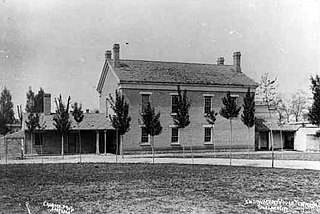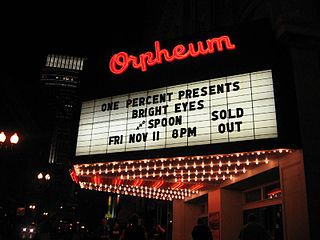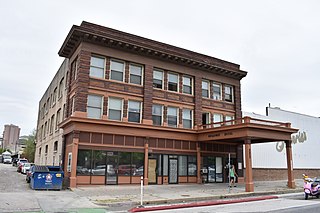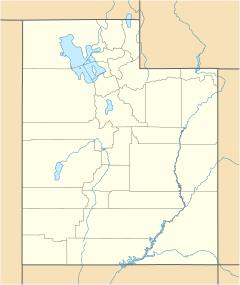
Salt Lake City, Utah has many historic and notable sites within its immediate borders. Although the entire Salt Lake City metropolitan area is often referred to as "Salt Lake City", this article is concerned only with the buildings and sites within the official city limits of Salt Lake City.

The Conference Center, in Salt Lake City, Utah, is the premier meeting hall for the Church of Jesus Christ of Latter-day Saints. Completed in 2000, the 21,000-seat Conference Center replaced the traditional use of the nearby Salt Lake Tabernacle, built in 1868, for the church's biannual general conference and other major gatherings, devotionals, and events.

Downtown is the oldest district in Salt Lake City, Utah, United States. The grid from which the entire city is laid out originates at Temple Square, the location of the Salt Lake Temple.

The Endowment House was an early building used by the Church of Jesus Christ of Latter-day Saints to administer temple ordinances in Salt Lake City, Utah Territory. From the construction of the Council House in 1852, Salt Lake City's first public building, until the construction of the Endowment House, the members of the LDS Church used the top floor of the Council House for administering temple ordinances. When this arrangement proved impractical, Brigham Young directed Truman O. Angell, architect of the Salt Lake Temple, to design a temporary temple. Completed in 1855, the building was dedicated by Heber C. Kimball and came to be called the Endowment House after the endowment ceremonies that were conducted inside it.

City Creek Center (CCC), commonly shortened to City Creek, is a mixed-use development containing an upscale open-air shopping mall, grocery store, and office and residential buildings near Temple Square in downtown Salt Lake City, Utah, United States. Opened on March 22, 2012, the development encompasses over 23 acres (9.3 ha) across portions of three city blocks. The center's mall includes a foliage-lined walkway with a simulated stream, meant to recreate City Creek, an important water source for the early settlers of Salt Lake City.

Mason School is located at 1012 South 24th Street in south Omaha, Nebraska, United States. Designed in the Richardson Romanesque style by the architectural firm of Mendelssohn, Fisher and Lawrie, the school was built in 1888 by the brick manufacturing and construction firm of Hadden, Rocheford & Gould. The school closed in the late 1970s and was converted into apartments. It was designated an Omaha Landmark in 1986 and listed on the National Register of Historic Places that same year.

The Orpheum Theater is a theater located in Omaha, Nebraska. The theater hosts programs best served by a more theatrical setting, including the Omaha Performing Arts Broadway Season, presented with Broadway Across America, and Opera Omaha's season. The theatre is listed on the National Register of Historic Places. The main auditorium is a proscenium theater known as "Slosburg Hall". The theater has a theatre organ, made by Wurlitzer.
Mendelssohn, Fisher and Lawrie was a significant architecture firm in early Omaha, Nebraska. Fisher & Lawrie continued. A number of their works are listed on the National Register of Historic Places.

The Pioneer Theatre Company (PTC) is one of four professional theatre companies in Utah, and the only fully professional theatre in Salt Lake City, contracting with union members belonging to Actors' Equity Association (AEA), Stage Directors and Choreographers Society (SDC) and United Scenic Artists (USA829). PTC was formed in 1962 and performs at the Simmons Pioneer Memorial Theatre on the University of Utah campus in Salt Lake City. The non-profit company produces seven plays each season, running from September to May, including classics, musicals, dramas, and comedies. The company creates its own productions on site, including costumes and scenery, while sometimes using actors and directors from out-of-state. Among a number of premieres, the company produced the nation's first regional premiere of Les Misérables in 2007, giving 82 sold out performances.
Herbert S. Auerbach was a prominent Jewish businessman in Salt Lake City and also a Republican member of the Utah House of Representatives.

The Minne Lusa Pumping Station was located along John J. Pershing Drive in the Florence neighborhood of North Omaha, Nebraska. The station, which was surrounded by settling basins, was the main source for pumping, filtering, and distributing Missouri River water throughout the City of Omaha. The station was the namesake of the Minne Lusa neighborhood located immediately to the south.
Richard Karl August Kletting was an influential architect in Utah. He designed many well-known buildings, including the Utah State Capitol, the Enos Wall Mansion, the original Salt Palace, and the original Saltair Resort Pavilion. His design for the Utah State Capitol was chosen over 40 competing designs. A number of his buildings survive and are listed on the U.S. National Register of Historic Places including many in University of Utah Circle and in the Salt Lake City Warehouse District.

The Utah State Fair is held at the Utah State Fairpark in Salt Lake City, Utah, United States. The fairgrounds are listed on the National Register of Historic Places. The fair takes place each year starting on the first Thursday after Labor Day and lasts for 11 days.

Fashion Place is an upscale shopping mall in Murray, Utah, United States. It opened in 1972, and is currently anchored by Nordstrom, Crate & Barrel, Macy's, and Dillard's.
Rocheford & Gould were brick manufacturers and construction contractors in early Omaha, Nebraska. The firm built numerous brick structures during Omaha's transition from the wooden buildings of Nebraska's territorial days to more permanent structures. The buildings the firm built included breweries, schools, packing houses, business blocks, Vaudeville theaters, street car barns and power houses, and civic buildings. Many of the structures the firm built have been demolished but a few of their earliest structures still exist and are listed on the National Register of Historic Places.

The Peery Hotel in Salt Lake City, Utah, is a 3-story Prairie style building that incorporates Classical Revival design elements. The hotel was designed by Charles B. Onderdonk and Irving Goodfellow and constructed in 1910 in what is now the city's Warehouse District. It was added to the National Register of Historic Places in 1978.

The McCornick Building, at 10 W. 100 South in Salt Lake City, Utah, was built in 1890–93. It is also known as the Crandall Building. It was listed on the National Register of Historic Places in 1977.

The Broadway Hotel is a historic hotel in Salt Lake City, Utah, United States.

Felt Electric, at 165 S. Regent St. in Salt Lake City, Utah, was built in 1893. It was listed on the National Register of Historic Places in 1982.
















